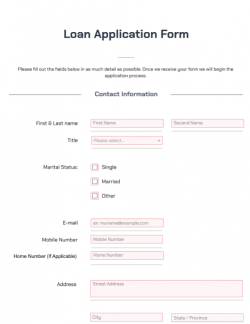
Create and host loan application forms in a few clicks with drag-and-drop form fields, automated data storage, and extensive content and templates library.
No credit card required

Even though they are relatively straightforward documents, loan application forms fulfill a wide range of informational functions. Most lenders consider them to be absolutely essential business documents, without which the loan application process wouldn’t be able to run smoothly.
Loan application forms are used to gather the following types of information:
Because most forms are hosted online nowadays, they provide an efficient way for lenders to gather information, request supporting documentation through upload links, and ask for legally-binding digital signatures from applicants.
While most loan application forms follow a similar structure and include fields for the same information-points, there are several unique applications. Differences tend to relate to the kind of loan that is being requested. A lender that offers short-term loans, for example, will require less information compared to a bank that deals primarily in mortgages for new homes.
Here is a quick overview of the different types of loans and their corresponding forms:
There are many other “niche” types of loans, such as car loans, equipment loans, student loans, but they will all usually fall into one of the categories above, and application forms will follow a similar format.
Loan application forms have a number of benefits. Most lenders consider them indispensable tools for managing the loan application process.
Here’s a quick rundown of the main benefits:
If your organization is considering offering loan services, then you will almost certainly need to provide customers with loan application forms.
While the content of loan application forms depends on the type of loans a company offers and how internal evaluation processes are set up, most forms tend to follow a recognized structure and include similar fields.
Here is an overview of the main areas that loan application forms tend to include:
Because loan application forms can be useful in a legal context, lenders may also include signature fields to prevent false statements.
A loan application form is a document used by individuals or businesses (especially new businesses) to request a loan from a lender such as a bank or credit union. Loan forms usually represent the first stage of a much broader eligibility evaluation process. Most lenders use loan application forms to filter early-stage candidates, conduct background and credit checks, and gather supporting documents.
Companies that regularly provide loan application forms will almost certainly benefit from using a template. Drafting an application form from scratch is an in-depth process and mistakes, such as accidentally-omitted fields, can be costly and difficult to rectify.
Working from a template, such as the free one provided by PandaDoc, will enable you to draft multiple documents in a fraction of the time it would otherwise take.
The loan application process is usually split into several distinct phases. After receiving a loan request, a lender will run multiple background checks to determine if a candidate is a suitable fit. If they pass this initial stage, potential borrowers will often be asked for further documentation and may also be invited for a face-to-face discussion. Finally, the lender will make an offer (which may or may not match the asked-for loan amount) along with an addendum for any associated repayment terms, interest rates, and relevant.
Smaller lenders dealing primarily with short-term loans sometimes rely exclusively on loan application forms (without any further stages involved) to decide whether or not they should lend money to an applicant. An application for a bank loan will be treated differently.
Some advisory organizations, including government bodies like the Small Business Administration (SBA) and nonprofits, may also use forms (for example, the SBA form) to help connect borrowers with lenders.